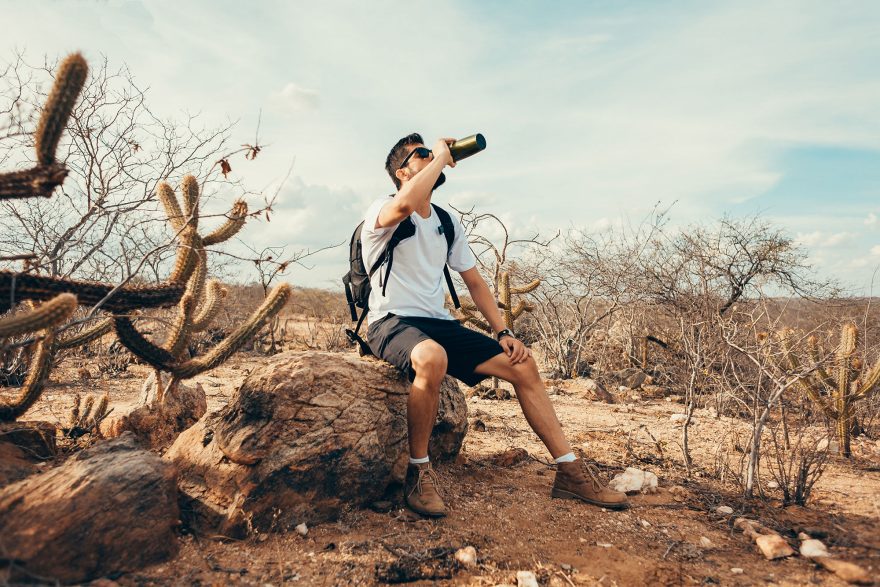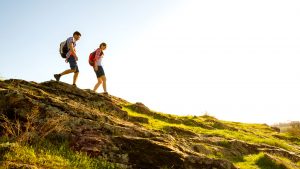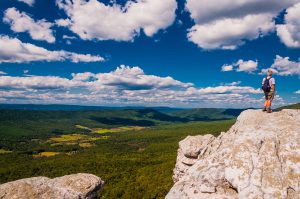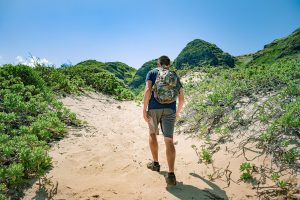
Image by Kleber Cordeiro, Shutterstock
Whether you live in an arid climate or a humid one, these 7 tips on hiking in hot weather will come in handy
For many people, sunny days and summer months are synonymous with hiking weather. After a long, cold winter, extended daylight hours and warmer temperatures do certainly lend themselves to spending more time in The Great Outdoors. However, hiking in hot weather — no matter whether we’re talking about an intense dry heat or a suffocatingly high humidity — requires some forethought and planning.
Before you lace up your hiking boots and attach your trekking poles to your pack, there are some things you should know to safely enjoy hiking in the heat — and you’ll hopefully get the most out of your experience:
Tips for hiking in hot weather
Whether you live in an arid desert climate or you’re headed to a humid area, these 7 tips on hiking in hot weather will come in handy:
1. Time Your Hike Carefully
In most places, the hottest part of the day is in the late afternoon, between 3 and 4 p.m. And te hours between noon and 3 p.m. have the most direct sunlight, as the sun continues to rise and temperatures gradually increase. Do your best to avoid hiking during this middle part of the day, and instead take the opportunity to hike in the early-morning or evening hours.
2. Know the Forecast
Even if you’re in an area with consistent weather — like Arizona, for instance — it’s a good idea to get in the habit of checking the forecast before hiking in hot weather. Especially at higher elevations and in the desert, the weather often changes without warning, and temperatures can fluctuate dramatically. With that in mind, remember that even if it’s cool when you start out, the weather can be very different just a mile or two away. Along the same lines, remember that even when it’s overcast, it can be very hot.

Image by maxpro, Shutterstock
3. Bring Lots — and Lots — of Water
Did you know that dehydration is one of the leading causes of heat exhaustion? Even on days where you’re not exerting much energy at all, it’s important to drink enough water to replenish fluids lost through simply breathing, sweating, or urinating.
Medical experts recommend that women drink roughly 2.7 liters of water per day, and 3.7 liters for men. However, those amounts should be substantially higher when hiking (or doing any other demanding physical activity, for that matter), as you’re exerting so much more energy. The Centers for Disease Control and Prevention recommend drinking approximately 8 ounces (or 1 cup) of water for every 15 to 20 minutes of physical activity. That means if you’re hiking for one hour, you should aim to drink about one quart or liter of water. If you’re hiking in hot weather for two hours, drink two quarts or liters, and so on.
4. Start Hydrating Before Your Hike
Drink plenty of water before starting your hike, not just while you’re actually hiking in hot weather. According to the CDC, if you’re dehydrated to begin with, you actually may not be able to drink enough to “catch up.” With that in mind, it’s a good idea to take small sips constantly, rather than waiting until you actually feel thirsty. This is a good everyday habit overall, not just in relation to hiking. Feeling thirsty indicates that your body is already “behind” in replacing fluids.
Don’t forget about post-hike hydration, also. Hiking in hot weather is hard work and there’s a good chance you sweat quite a bit. Drinking plenty of water to replace those lost fluids is crucial to properly recovering from your hike.
5. Don’t Skip Sunscreen
Just about everyone knows that we should wear sunscreen, but not everyone knows why. You’re constantly exposed to the elements while you’re hiking, with the sun’s harmful UV rays beating down on you (yes, even when it’s cloudy). Too much UV exposure is closely linked to skin cancer and other major health issues, and one of the best ways to protect yourself is simply wearing sunscreen. In fact, according to Cancer Research UK, “Getting sunburnt just once every two years can triple your risk of melanoma skin cancer, compared to never being burnt.”
Try and make a habit out of applying sunscreen every morning, before you do anything else — at the very least, before hiking in hot weather. Dermatologists recommend using at least SPF 15, and you may want to consider getting a water-resistant or sweat-proof sunscreen for hiking. Apply sunscreen 15 minutes before sun exposure, and re-apply every two hours as long as you’re outside.
6. Plan Your Hike Around Water
Whenever possible, try to hike near a body of water such as a lake, river, or the ocean. That way, you can jump in and cool off whenever you start feeling too hot! This is also a wonderful way to break up longer hikes.

Image courtesy of JonBilous, Shutterstock
7. Save Tough Hikes for Cooler Weather
Don’t attempt a very difficult hike when it’s extremely hot. Stick with easier or familiar hiking trails, and take your time. Stop to rest often — in the shade when possible, take small, frequent drinks of water, and jump in the water if it’s nearby.
Hiking in Humidity
Hiking in hot weather presents a number of challenges, but humidity adds a whole new level of complexity. Generally speaking, hiking in humidity causes you to become both fatigued and dehydrated faster. Another major concern is that the added moisture in the air leaves you damp and limits the body’s ability to evaporate sweat. This can cause you to overheat or even feel cold, regardless of the outside temperature.
All of these factors make it substantially more difficult to regulate your body temperature when hiking in humidity as opposed to dry heat. To counteract this, consider adding an electrolyte solution to your water and drinking it about 30 minutes before starting your hike. You can also take sodium tablets, which contain not only salt but also typically magnesium, potassium and other electrolytes.
What to Wear for Hiking in Hot Weather
Bringing and drinking plenty of water is often top of mind for most people (as it should be!), but it’s very easy to overlook what you wear — and it makes a tremendous difference. Next time you’re planning on hiking in hot weather, here are some clothing items and tips that will help keep you comfortable and offer some relief from the sun.
- Choose light colors and loose-fitting pieces. As you sweat, you’ll be more comfortable if your clothing isn’t skintight.
- Opt for lightweight, breathable, and moisture-wicking fabrics. Synthetic options like nylon and polyester are usually excellent choices. Cotton can work also, but be aware that it typically dries slowly and absorbs moisture, rather than wicking it away.
- Wear long sleeves. Although it sounds counterintuitive, covering up exposed skin actually provides important physical protection from harsh sun rays. You can also look for clothing with a UPF rating, which goes a step further than physically covering the skin and helps to block rays, much like sunscreen.
- Wear a hat. The skin on your face, ears, and neck is extremely delicate and likely to burn first (if you’ve ever experienced a burned scalp or ears, you know exactly what we mean!). Wearing a brimmed hat provides valuable protection for these areas, plus helps keep you cool. As a general rule, the wider the brim, the better, but any hat is better than no hat.
- Choose your socks carefully. Trust us, you don’t want to be hiking in wet or damp socks. Not only is it extremely uncomfortable, that’s the perfect recipe for blisters. For the reasons mentioned above, wool or synthetic-blend socks are a better bet than cotton.
- Wear a neck gaiter. Along the same lines as wearing long sleeves, a neck gaiter offers valuable coverage and sun protection. You can alternate between wearing it around your neck and on your head as a headband, plus you can wet it for an instant cooling effect.

Image by KieferPix, Shutterstock
Warning Signs of Heat Stroke and Heat Exhaustion
Aside from taking steps to protect yourself while hiking in hot weather, it’s smart to be familiar with signs of heat illness such as heat exhaustion and heat stroke. Both of these, along with other heat-related illnesses including heat cramps, are closely associated with dehydration — so we cannot overstate the importance of proper hydration.
Heat Stroke Symptoms
Heat stroke often occurs without warning and is the process of the body literally overheating. It is a very serious medical condition that requires immediate attention, so if you or your adventure partners display any of the following symptoms, seek help right away. You should also make attempts to lower the body temperature as quickly as possible by removing layers and drinking small amounts of water.
- Intense muscle cramps
- Headache, particularly when accompanied by throbbing
- Nausea and/or vomiting
- Dizziness
- Lack of sweating
- Disorientation
Heat Exhaustion Symptoms
Heat exhaustion is typically the result of prolonged exposure to extreme heat and direct sunlight. It almost always goes hand in hand with severe dehydration, and is the body’s way of simply shutting down because it can’t properly manage the heat. If you suspect that someone in your party is suffering from heat stroke, find shade immediately and rest. Drink water, along with salt tablets or other electrolytes, if available. You can also attempt to cool off by splashing water on yourself or dipping a bandanna or towel in water and wrapping it around your neck or head.
- Cool, clammy skin or heavy sweating
- Feeling faint or dizzy
- Rapid heart rate
- Nausea
- Fatigue
- Headache
- Muscle cramps
Taryn Shorr is an avid outdoor enthusiast, frequent traveler, and wannabe photographer based in southern Arizona. She lives for the opportunity to explore The Great Outdoors, both at home and in new destinations, and firmly believes that nature is a form of both therapy and religion.

 Your Privacy Choices
Your Privacy Choices